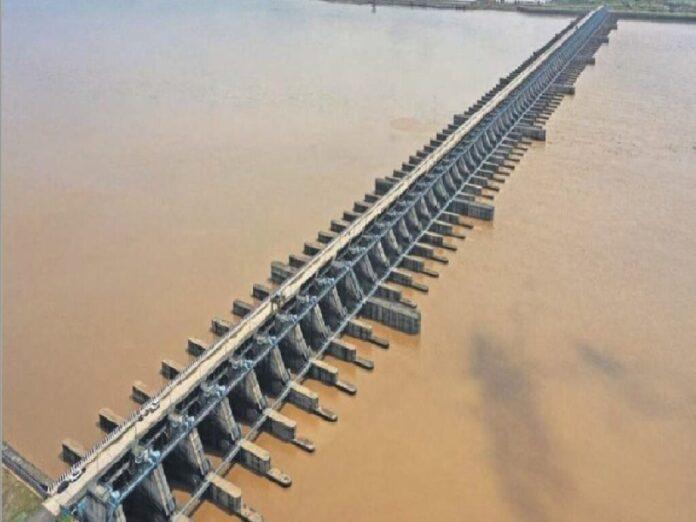Recently (on October 22, 2023), five pillars of the Medigadda barrage of the Kaleshwaram Lift Irrigation Project (KLIP) in Telangana sank into the River Godavari. The incident caused a major setback to the project, which is considered to be a prestigious undertaking of the Telangana government.
Authorities have suspended traffic on the bridge connecting Telangana and Maharashtra, which is located on top of the barrage. They have also ordered a probe into the incident, including a suspected sabotage angle.
The Kaleshwaram project is a massive irrigation project that aims to lift water from the Godavari River to irrigate over 1.2 million acres of land in Telangana. The project consists of several barrages, pump houses, and canals.
The Medigadda barrage is one of the key components of the Kaleshwaram project. It is a 2.1 km long barrage with 212 pillars. The barrage was constructed in a record time of 18 months and was inaugurated in June 2020.
The sinking of the barrage pillars has raised concerns about the quality of construction of the Kaleshwaram project. The opposition parties in Telangana have accused the government of corruption and negligence.
The Telangana government has defended the project, saying that it is safe and that the sinking of the barrage pillars is a minor incident. However, the government has not yet released a detailed report on the incident or the steps it is taking to prevent such incidents from happening in the future.
The National Dam Safety Authority (NDSA) deputed a team of officials on Monday, 23 October, to visit Lakshmi (Medigadda) barrage of the Kaleshwaram Lift Irrigation Project (KLIP) and study the reasons for the sinking of pillars No 15 to 20 of the sixth to eighth blocks on the night of 21 October.
The committee, constituted as per Schedule II of the Dam Safety Act, 2021, will interact with all the stakeholders, including officers of the Water Resources Department of Telangana, the State Committee on Dam Safety (SCDS), and the Telangana State Dam Safety Organisations (SDSO), the agency involved in the construction of the barrage.
The committee has been asked to submit a detailed report indicating the reasons for the incident.
The committee is headed by NSDA Chairman Anil Jain.
Committee members
The Ministry of Jal Shakti ordered the inquiry after Union Minister G Kishan Reddy shot off a letter to the minister, seeking a probe into the factors that led to the sudden sinking of the barrage’s piers.
The committee members are expected to visit the site after holding talks on Tuesday, 23 October, with state government officials and others involved in the construction and maintenance of the barrage.
Kishan Reddy, in his letter to Jal Shakti Minister Gajendra Singh Shekawat, raised concern over the release of 10 tmcft water by opening all 85 gates after the piers sank.
He said it was not only a waste of water but also posed a threat to the safety of people living in the villages downstream. He recalled how the Annaram and Kannepally pump houses of the Kaleshwaram project were submerged due to the floods last year.
Terms of the inquiry
The minister specifically sought an inquiry into whether foundation investigations were done and whether the “borehole samples” were taken to know how much compaction needed to be done before the project designs of this barrage were made.
He also wanted the inquiry to cover whether the river cross-section studies were done at both pre- and post-monsoon times to study the upstream and downstream cross-sections and compare the model studies with ground reality.
He said the piers seemed to have failed because the soil was still settling and it was not treated properly.
“This indicates that it is a fit case of foundation inspection failure. The inquiry should also cover whether the designing responsibility was given to the construction agency under the EPC (Engineering, Procurement and Construction) method or whether the designs are done by the State Irrigation Department’s CDO (Central Design Organisation), and responsibility needs to be fixed accordingly,” he said.
About the barrage
The Lakshmi Barrage, also known as the Medigadda Barrage, is strategically positioned at the inception of the project, just downstream from the confluence of the Pranahitha river. This juncture ensures a minimum assured flow of 300 tmc of water.
The Kaleshwaram project — claimed to be the largest such lift irrigation project in the world — is designed to facilitate the lifting of 160 thousand million cubic feet (tmc) of water annually, at the rate of 2 tmc per day.
The first component, known as the Lakshmi Barrage, in conjunction with the Lakshmi Pump House, is responsible for the water-lifting operation from this point.
Moving upstream along the Godavari river, the Saraswati Barrage is the second structure, and the Saraswati Pump House is tasked with the responsibility of water lifting from this location.
Subsequently, the system includes the Parvathi Pump House, which channels water to the long-standing Sripadasagar-Yellampalli Reservoir. From this reservoir, water flows to the Gayatri Pump House, located underground.
Parvathi, Saraswathi, and Lakshmi are the newly constructed barrages, each with a daily water-lifting capacity of 2 tmc. Unfortunately, the Lakshmi Barrage is currently in a state of disrepair, and water lifting from this particular barrage is temporarily halted.
According to experts, addressing this issue requires the involvement of expert committees and the Central Water Commission (CWC).
Since its builder, the engineering and construction giant L&T, is responsible for operations and maintenance (O&M), it will be responsible for devising and implementing the necessary remedial measures. Meanwhile, the other pumphouses could continue their operations uninterrupted.
Such extensive damage to a barrage, especially during a non-flood time, is a first in the country.
The original design specified a maximum discharge capacity of 28.25 lakh cusecs of water. Astonishingly, last year’s flood surpassed this capacity, reaching 28.7 lakh cusecs.
The inauguration of the Lakshmi Barrage took place in 2019, in the presence of the presence of Telangana Chief Minister K Chandrashekar Rao and the then chief ministers of Andhra Pradesh, and Maharashtra.
Lakhsmi barrage is 1.6 km long with a storage capacity of 16.17 tmc which can irrigate thousands of hectares of land and provide water to millions including the citizens of Hyderabad.
The project aims at increasing the total cultivable command area (the sustainable area which can be irrigated after accounting for both upstream and downstream factors) by 1,825,000 acre⋅ft (2,251 hm3) across all 13 districts in addition to stabilising the existing command area.
The National Green Tribunal (NGT) declared the scheme was constructed without following the statuary provisions with regard to environmental aspects.
Four major pumping facilities manage the project’s outflow, the largest at Ramadugu (Medaram, Annaram and Sundilla being the others) is also likely to be the largest in Asia once consistent measurements are available.
It used seven 140 MWh (500 GJ) pumps designed and manufactured specifically for the project by the BHEL. The Engineering giant Megha Engineering and Infrastructures Limited built 15 of 22 Pump houses and undertook a major part of the project.
The sinking of the barrage pillars has also raised concerns about the safety of other dams and barrages in India. Experts have called for a thorough review of the safety standards of all dams and barrages in the country. ■ #hydnews #khabarlive #hydkhabar







